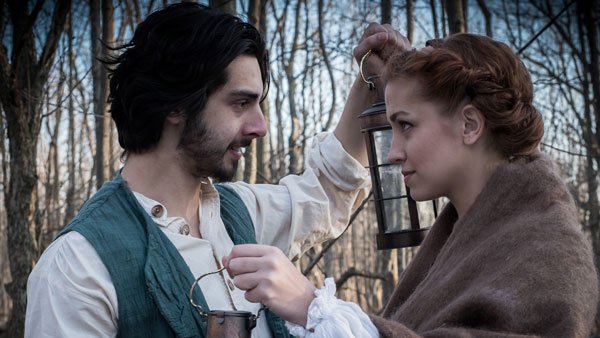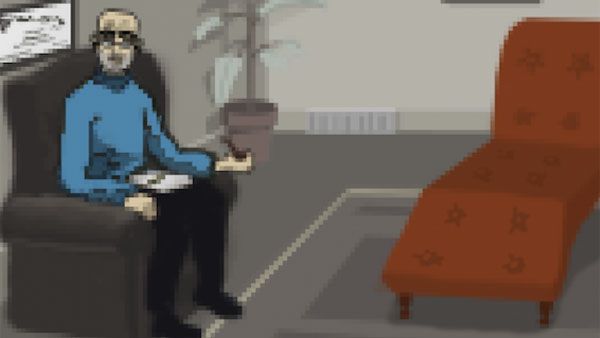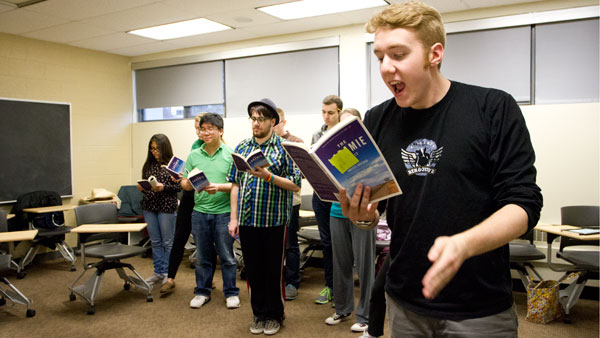It’s an object known by many names: the Textor Ball, the Textor Fish, the golf ball from the gods, or, more sensationally, as the structure that will roll off the hill if a virgin graduates from the college. While the campus continues to wonder about the structure’s backstory, the one Ithaca resident who knows its truth is its creator.
Jack Squier, a Master of Fine Arts ’52 graduate of Cornell University, designed and built the Textor Disc, which today is iconic at the college. Squier, who taught sculpture at Cornell for 45 years before retiring in 2011, lives in Ithaca during the summer and fall, spending the rest of his time in Florida.
Squier met President Tom Rochon in July 2013 to celebrate the Textor Disc’s renovation. Rochon said Squier was pleased with the condition of the sculpture.
“It was like seeing a legend come to life,” Rochon said via email. “Mr. Squier had not seen his sculpture for a number of years. He noted with approval that it has been well cared for, adding ruefully that it is holding up better than he is.”
Nearly 50 years ago, a tractor trailer pulled up outside Textor Hall carrying a giant object covered in black tarpaulin. Several students gathered on the stone patio, whispering and watching the object’s installation in preparation for Ithaca College’s 75th Anniversary celebrations.
The beginnings of the Disc go back to the late ’60s, after then-college President Howard Dillingham saw a seven-inch model of the sculpture at one of Squier’s exhibitions in New York City. The model was one in a series of abstract heads that Squier had designed.
Squier said Dillingham had asked him if he could make a bigger version of the Disc for the college to fill a central location on campus. David Mandeville, a former trustee and attorney in Elmira, N.Y., paid to have it built and dedicated the Textor Disc to his grandfather, Hubert Mandeville.
So Squier began work on the sculpture at the Cornell Foundry. With the help of an assistant, he finished it during the summer of 1967, working six days a week before it was installed on campus in the fall.
The sculpture, which is 10 feet in diameter and 6 feet through the center, is made largely of steel and fiberglass, Squier said.
“We made a steel frame, which was embedded in styrofoam,” he said. “The piece was carved in foam and then laminated over the foam core with polyester resin and fiberglass. Finally, that was all smoothed out and covered in aluminum leaf.”
Squier said there was a heavy machine operators’ strike two or three days before the Disc was to be installed. Therefore, they had to use a come-along tool, which is a chain fastened to a tree, in order to bring the Disc across the lawn and up the Textor Hall stairs, he said.
Carl Sgrecci, former vice president of finance and administration at the college, was a first-semester transfer student in October 1967 and was one of the students to watch the sculpture arrive on campus.
“We had just stepped out [of class], and a bunch of us were standing around talking there on that stone patio outside of Friends Hall,” he said.
Sgrecci said he and his friends had different predictions about the unveiled structure.
“Students can always be smart alecks; no offense, I was one too,” Sgrecci said. “So we were just all speculating what it might be. I remember one of the students saying, ‘Maybe it’s a big bust of Mrs. Dillingham’ … She was recognized on campus by the students.”
The Textor Disc is not the only one in the series of “Heads” sculptures still standing. Another larger version of the Disc is in front of the Castellani Museum at Niagara University.
Squier said the hypotheses and folklore surrounding the sculpture on Ithaca’s campus have amused him. Dispelling some of the lingering myths, he said the sculpture is an abstract piece.
“It’s an abstraction based on a series I did called ‘Heads,’” he said. “This was a big version of one of them. [Dillingham and I] decided to call it a Disc to keep it from sprouting mustaches.”











